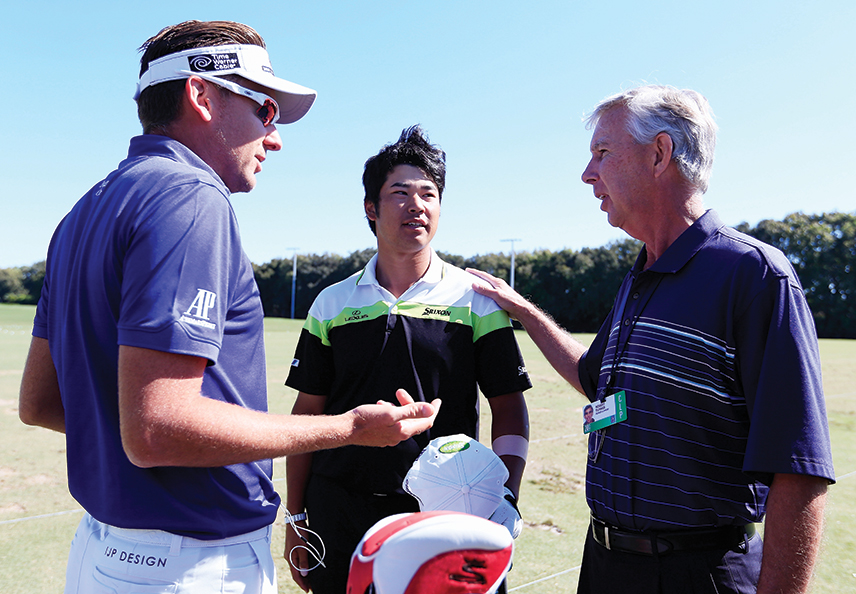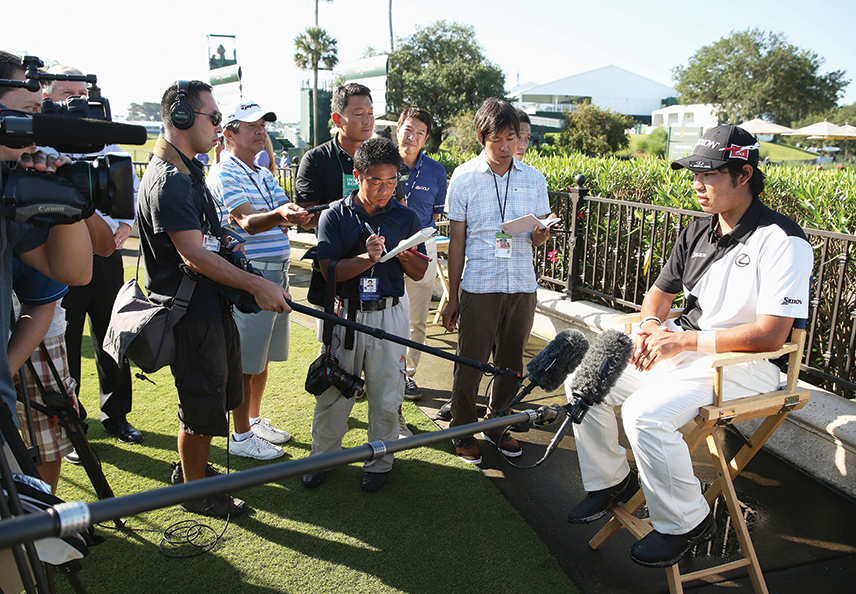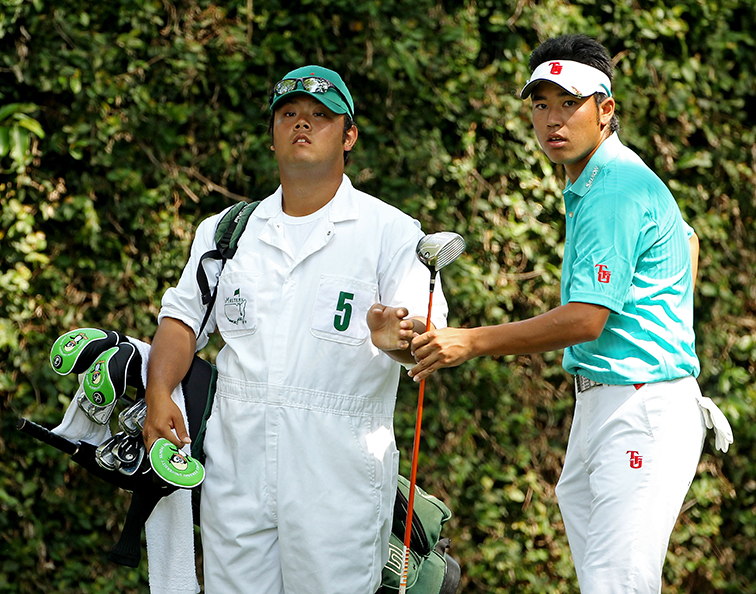FOR all his fame and fortune, there is one thing Hideki Matsuyama has to search hard for: a good Japanese meal in the United States.
Hard to believe? Well, the Japanese golf star’s quest for familiar food is enough to influence his US PGA Tour schedule. One of the biggest lures for Matsuyama to contest the two-tournament Hawaii swing in January was a particular restaurant in Honolulu. It’s called ‘Shinn’, and the 25-year-old claims the Waikiki establishment is among the best Japanese food offerings in North America.
“It’s one of the reasons why he came to the Sony Open,” his translator, Robert Turner, tells Australian Golf Digest.
Matsuyama insisted this writer and a few other media representatives visit Shinn, so of course we took his advice. Incredible sushi, traditional Japanese dishes and a mouth-watering barbecue – it’s no secret why this menu keeps Matsuyama coming back. Shinn’s Japanese owner happened to be seated at the table adjacent to ours. When told our group was sent by the biggest sports star in his country, his face lit up like a starstruck child’s.
It seems you don’t have to be at a golf course to realise Hideki Matsuyama is a big deal in Japan.

The Aloha State
Aside from memorable Japanese cuisine, the catalyst for Matsuyama’s trip to the Islands of Aloha was claiming dual wins in 2015 – at the Phoenix Open in February and the WGC–HSBC Champions in October. Matsuyama thus became eligible for the recent 32-man Tournament of Champions at the famous Plantation course at Kapalua on Maui.
Of course, confirming a spot at the Sony Open on the island of Oahu the week after meant regular visits to Shinn. “What I like about the Sony Open is the food that we find here in Honolulu,” said Matsuyama. “Hopefully I can come back here every year.”

Celebrity Status
Last year was enormous for Hideki Matsuyama. It began with a missed the cut at the Farmers Insurance Open at Torrey Pines – and a subsequent drop to world No.19 – but four wins and a runner-up in his last five international starts ensured he ended the year 13 spots higher.
A star in Japan but relatively unknown to most of the golf world, Matsuyama was thrust into the limelight almost overnight.
“Since Hideki jumped into the top 10 in the world rankings, there’s been a lot more attention, especially from the non-Japanese media,” says Turner, an American fluent in Japanese. “A lot of folks around the world don’t know Hideki well, and they’d like to get to know him better.”
The purple patch started in October when Matsuyama claimed the Japan Open by three strokes. Two weeks later in Shanghai, he became the first Asian golfer to win a World Golf Championship event – and by a whopping seven shots. Arriving home to huge fanfare, Matsuyama blitzed the field at the Taiheiyo Masters – another seven-shot triumph – to bag his eighth win in Japan. The globetrotter then flew to Melbourne to team up with Ryo Ishikawa at the World Cup of Golf at Kingston Heath, where Team Japan finished tied for sixth at the two-man teams event.
By now, he’d become a national hero.
Naturally, when Matsuyama claimed the Hero World Challenge in the Bahamas in December – where host Tiger Woods returned to competitive golf after 16 months recovering from back surgery – Hideki hysteria levels reached fever pitch.
“There’s quite a few sports papers in Japan and he’s been on the front page quite a few times,” says Turner. “Especially since his victory in Shanghai; that was a very big win for him and for Japan. Not only his popularity, but the popularity of men’s golf in Japan really took a boost with that win.”
Matsuyama concurred that winning what is regarded as ‘Asia’s Major’ was the highlight of a stellar year.
“To win the HSBC was probably my biggest achievement,” said Matsuyama. “I didn’t know it while I was playing, but I was the first Asian to win that event, and so to me, that was a big deal.”
The secret to his world-beating run?
“I wish I knew!” laughs Matsuyama. “I think if there’s a secret or a key, it’s been my putting. Confidence is a huge part of golf, and I’ve had that the past couple months.”

Backing Up
A New Year’s break seemed to have no effect on Matsuyama’s momentum. This scribe witnessed his first tee shot of the year during a Monday practice round at Kapalua – a blocked slice he was disgusted with. But by the end of the week, Matsuyama would be paired with Justin Thomas in the final group on the hilly Plantation course, making the 23-year-old American work for every shot of his eventual victory.
More than 20 Japanese journalists were on hand to witness Matsuyama earn runner-up honours, and a week later in Honolulu that travelling pack grew to a whopping 23 of the 45 reporters in the media centre. But Matsuyama sees the bright side of receiving most of that attention.
“I’m happy they (journalists) are here; they are doing their job. Sometimes it’s good if not too many come,” he laughs. “But hopefully that [coverage] helps build golf in Japan.”
But being a Japanese celebrity, hype doesn’t just come from reporters – he was the only golfer in the 144-player Sony Open field being chased by screaming fans daily from the scorer’s hut to the player’s lounge at Waialae Country Club. Not even Jordan Spieth received as much attention.
“When I go back to Japan, more people recognise me, and it makes it a little more difficult to go out for meals and things,” Matsuyama says. “Even here in America, I’ve noticed people (staring). When I go out to dinner, I don’t speak a lot of English, and so we don’t get into a conversation. But I think some of them, they recognise me. It’s a good feeling.”
So what’s needed for 2017 to be considered a success?
“A successful year would be winning multiple times, and of course winning a Major,” says Matsuyama. “I am looking forward to another good year. The expectations of people around me are high. I know other people expect a lot of me, and so all I can do is just try my best. I just have to play my own game and not try to live up to anybody else’s expectations except myself.”
Tough less of a parameter, golf’s top spot is in the back of his mind. Yet Matsuyama acknowledges there’s plenty of work to usurp Australia’s world No.1 Jason Day.
“Becoming No.1 in the world is the goal I think of all of us out here. I still have some weak links in my game that I have to work on. As you know, Jason hits it long and he just has a wonderful short game. I don’t even come as close to hitting as long as he does. So that’s one of the areas that I really need to work on, and hopefully I can do that.”

At the Majors
With a population nearing 130 million, Japan has exported several legendary golfers throughout history – World Golf Hall of Fame members Jumbo Ozaki and Isao Aoki as well as Ryo Ishikawa, to name a few. Though adored by fans, none managed to win one of golf’s four Major championships. Already with more US PGA Tour wins than any of his predecessors, Matsuyama is perhaps the best candidate to end his nation’s Major hoodoo.
“It would be big news,” Matsuyama says about a first Grand Slam for Japan. “I mean, if I was fortunate enough to win a Major, I know in Japan it would be massive.”
Like most golfers, the Masters is high on the list. Matsuyama’s first taste of Augusta National came as an amateur in 2011 after winning the 2010 Asia Pacific Amateur Championship in Japan. He finished as low amateur at Augusta, tied for 27th, and returned a year later courtesy of successfully defending his Asia Pacific title.
“My first time at Augusta National, I was just hoping to be able to play four days. In reality, I just didn’t want to embarrass myself in two days.”
As a professional, his past two results at the Masters have been fifth in 2015 and tied seventh last year.

Rising Son
So how did Matsuyama reward himself during a brief holiday?
“Probably drinking sake,” he laughs. “I had my share. It wasn’t just a little; we did party pretty good.”
When he wasn’t sipping on Japanese rice wine, there was some long-awaited father-and-son golf.
“Playing golf with my father,” Matsuyama says when asked what else he did to relax. “My father, when he played a lot, he was probably a plus-two [handicap]. We hadn’t played together for probably 10 years. This past off-season, we were able to play. It was special.”
The Matsuyama File
Born: February 25, 1992
Birthplace: Ehime, Japan
Height: 180 centimetres
Weight: 82 kilograms
College: Tohoku Fukushi University
Turned professional: 2013
Tournament victories: 12
Japan Golf Tour: 8
US PGA Tour: 3
World Golf Championships: 1
Other Achievements
2010: Won Asia-Pacific Amateur Championship
2011: Leading amateur at the Masters
2011: Won Asia-Pacific Amateur Championship
2012: No.1-ranked amateur in the world
2013: Led Japan Golf Tour moneylist
Best finish @ the Majors
Masters: 5th (2015)
US Open: T-10 (2013)
British Open: T-6 (2013)
US PGA Championship: T-4 (2016)
